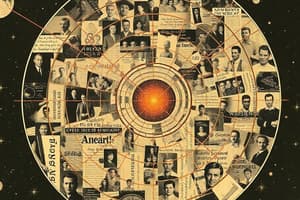Podcast
Questions and Answers
What phenomenon does the equinox represent?
What phenomenon does the equinox represent?
- When the Sun crosses the equator, leading to equal day and night (correct)
- When the Moon is in line with the Earth and Sun
- When the Earth is closest to the Sun
- When the Sun is farthest from the equator
Which of the following best describes the geocentric model?
Which of the following best describes the geocentric model?
- A theory that the Sun is at the center of the universe
- A theory positing Earth as the center of the universe with celestial bodies rotating around it (correct)
- A concept developed solely by Newton
- A model explaining elliptical orbits of planets
What did Copernicus propose regarding the heliocentric model?
What did Copernicus propose regarding the heliocentric model?
- That all celestial bodies are stationary
- That the Sun revolves around the Earth
- That planets move in elliptical orbits due to gravity
- That Earth and other planets revolve around the Sun (correct)
How did Johannes Kepler contribute to the understanding of planetary motion?
How did Johannes Kepler contribute to the understanding of planetary motion?
Which law explains the elliptical orbits of planets?
Which law explains the elliptical orbits of planets?
Flashcards
Geocentric Model
Geocentric Model
The incorrect theory that the Sun and planets orbit around Earth. It dominated for almost 2000 years.
Heliocentric Model
Heliocentric Model
The correct theory that Earth and other planets revolve around the Sun.
Equinox
Equinox
The dates the Sun crosses the equator and day and night are approximately equal in length.
Johannes Kepler
Johannes Kepler
Signup and view all the flashcards
Law of Universal Gravitation
Law of Universal Gravitation
Signup and view all the flashcards
Study Notes
Equinox
- Equinox represents dates when the Sun crosses the equator, creating approximately equal day and night lengths.
- This occurs on March 21st and September 21st.
Geocentric vs Heliocentric Models
Geocentric Model
- Incorrect theory; the Sun, Moon, and stars appear to revolve around Earth.
- Earth believed to be the center of the universe.
- Proposed by Aristotle and Ptolemy.
- Remained the dominant theory for nearly 2,000 years.
- Ptolemy used epicycles (circular motions on circular motions) to explain non-circular planetary orbits around Earth.
Heliocentric Model
- Correct theory; Earth and other planets revolve around the Sun.
- Proposed by Copernicus in the 1500s.
- Explained retrograde motion (planets appearing to reverse their direction) of planets by Earth's smaller orbit "lapping" other planets.
- Johannes Kepler calculated that planets move in ellipses (oval paths).
Law of Universal Gravitation
- Newton's law explains elliptical planetary orbits.
- Orbits result from the balance between gravitational attraction and a planet's tendency to move in a straight line.
Studying That Suits You
Use AI to generate personalized quizzes and flashcards to suit your learning preferences.




